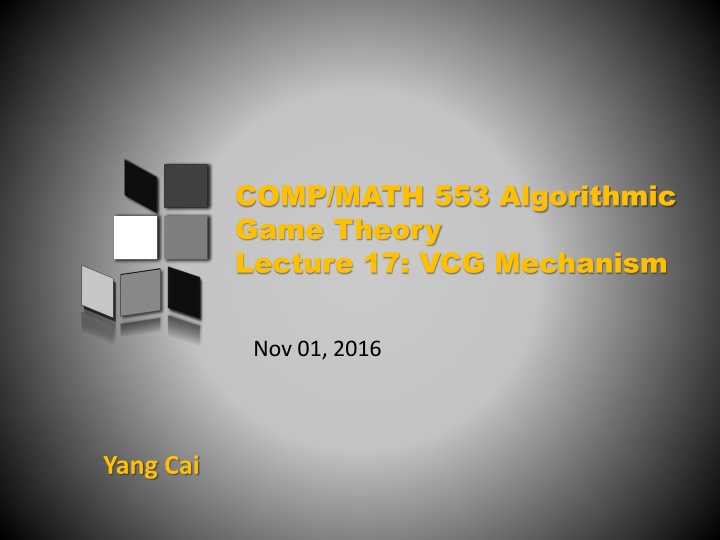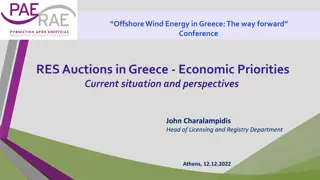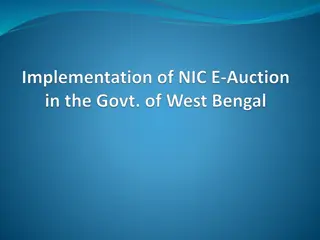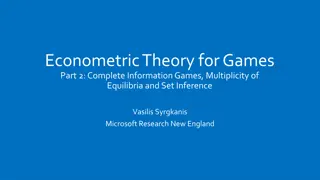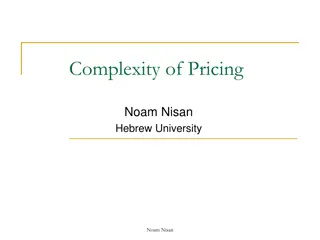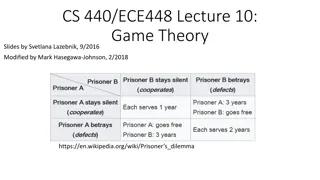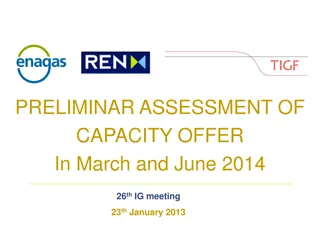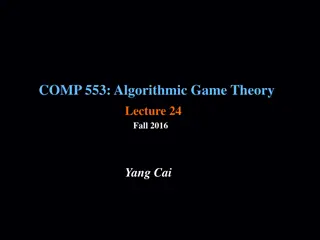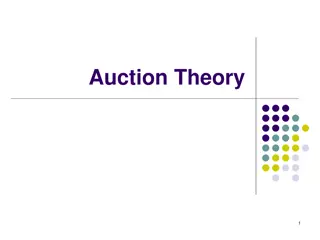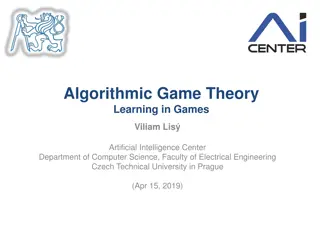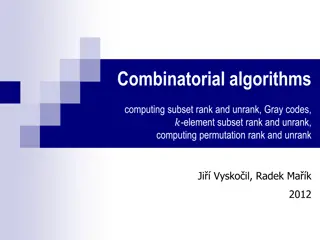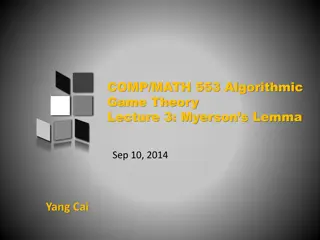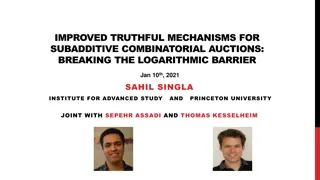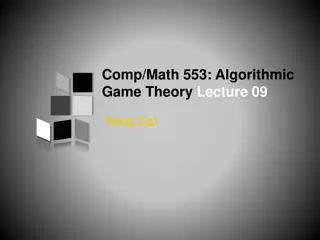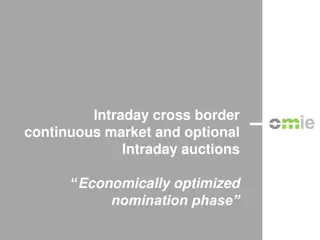Algorithmic Game Theory: VCG Mechanism and Combinatorial Auctions
Delve into the intricate world of Algorithmic Game Theory as we explore the Vickrey-Clarke-Groves (VCG) Mechanism and its applications in Combinatorial Auctions. Understand the principles behind maximizing social welfare, allocation rules, and payment mechanisms with real-world case studies. Explore the challenges and practical implications of applying VCG in various auction scenarios, from spectrum auctions to bilateral trading.
Download Presentation

Please find below an Image/Link to download the presentation.
The content on the website is provided AS IS for your information and personal use only. It may not be sold, licensed, or shared on other websites without obtaining consent from the author.If you encounter any issues during the download, it is possible that the publisher has removed the file from their server.
You are allowed to download the files provided on this website for personal or commercial use, subject to the condition that they are used lawfully. All files are the property of their respective owners.
The content on the website is provided AS IS for your information and personal use only. It may not be sold, licensed, or shared on other websites without obtaining consent from the author.
E N D
Presentation Transcript
COMP/MATH 553 Algorithmic Game Theory Lecture 17: VCG Mechanism Nov 01, 2016 Yang Cai
Menu Vickrey-Clarke-Groves Mechanism Combinatorial Auctions Case Study: Spectrum Auctions
The VCG Mechanism [The Vickrey-Clarke-Groves (VCG) Mechanism] In every general mechanism design environment, there is a DSIC mechanism that maximizes the social welfare. In particular the allocation rule is x(b) = argmax i bi( ) (1); and the payment rule is pi(b) = hi(b-i) j ibj( *) (2), where * = argmax i bi( ) is the outcome chosen in (1).
Examples of VCG Public Project Problem bidders have values ?? 0 for bridge social choice function: build bridge iff sum of bidders values for bridge ??? exceeds cost ? of bridge. VCG does not apply directly, but can introduce dummy bidder representing the auctioneer, with cost ? if bridge is built and 0 otherwise VCG with Clarke payments: build bridge iff ??? ? if bridge not built, no bidder pays anything if bridge is built, only pivotal players i pay equal to ? ? ??? Claim: Total payments are always ?. Equality only holds if ???= ?. Proof: on board
Bilateral Trading 1 buyer and 1 seller (not the auctioneer) The seller holds an item an values it at ??, the buyer values it at ?? Two outcomes {trade, no-trade} Social welfare maximization means: trade if ?? ?? and no-trade o.w. Claim: If the VCG mechanism has 0 payments for both the buyer and seller when there is no-trade, then the mechanism needs to subsidize the trade. Proof: on board.
VCG Mechanism [The Vickrey-Clarke-Groves (VCG) Mechanism] In every mechanism design environment, there is a direct DSIC mechanism that maximizes the social welfare. Its allocation rule is x(b) = argmaxa i bi(a) and price rule is pi(b) = maxa j i bj(a) j ibj( x(b) ) Discussion: DSIC mechanism that optimizes social welfare in any mechanism design problem ! often impractical. serves as a useful benchmark for more practical approaches.
Combinatorial Auctions (intro) Important in practice - spectrum auctions - allocating take-off and landing slots at airports Notoriously hard in both theory and practice - In theory, many impossibility results for what can be done with reasonable communication and computation - In practice, badly designed combinatorial auctions with serious consequences
Combinatorial Auctions (model) n bidders o e.g. att, verizon, t-mobile and several regional providers. set M of m non-identical items. o e.g. licenses for broadcasting at a certain frequency in a given region. an outcome is a n-dimensional vector (S1, S2, ..., Sn), with Si denoting the set of items allocated to bidder i (her bundle). All Si s are disjoint! There are (n+1)moutcomes
Combinatorial Auctions (model) Bidders may value different bundles in complex ways. Bidder i has a private value vi(S) for each subset S of M. o Each bidder needs 2m numbers to specify her valuation. We make the following assumptions about bidders valuations: o vi ( ) = 0 (normalization) o vi(S) vi (T), if S is a subset of T (free disposal) o depending on application may make further assumptions about the valuations - simplifies auction design problem The welfare of an outcome (S1, S2, ..., Sn) is i vi(Si).
Combinatorial Auctions (challenges) How to optimize social welfare in combinatorial auction settings? Easy answer: Run VCG! Unfortunately, several impediments to implementing VCG. Challenge 1 -- Preference elicitation:Is direct-revelation sealed-bid auction a good idea? No! Each bidder needs 2m numbers to specify her type. When m=20, this means ~1 million numbers for every bidder. Solutions: o Assume bidder valuations come from a simple to describe class, e.g. single-minded/additive/unit-demand bidders o Resort to indirect mechanisms - may be hard to argue about incentives
Indirect Mechanisms (example) Ascending English Auction. Many variants, the Japanese variant is easy to argue about: The auction starts with some opening price, which is publicly displayed and increases at a steady rate. o Each bidder either chooses to stay in or drop out, and once a bidder drops out she cannot return. o o The winner is the last remaining bidder, and the sale price is the price at which the second-to-last bidder dropped out. Each bidder has a dominant strategy: stay in until the price is higher than her value. Applying the revelation principle to this auction recovers the Vickrey auction with reserve price.
Indirect Mechanisms (discussion) We d like to generalize the English auction to multi-item settings. We ll discuss auction formats used in practice for the spectrum auctions. Main question: can indirect mechanism achieve non-trivial welfare guarantees? Lots of work. Short answer: depends on bidders valuation functions. For simple valuations, qualified yes ; for complex valuations, no .
Combinatorial Auctions (challenges) Challenge 2: Computational Intractability o even if bidder types are known to auctioneer, the auctioneer still needs to find a welfare-maximizing allocation o this is not always tractable e.g. maximizing welfare for single-minded combinatorial bidders is NP- Hard (reduction from independent set) o Possible solution: approximation if welfare cannot be optimized exactly, use approximation algorithm if bidder types are known to auctioneer if not, all bets are off VCG mechanism does not remain DSIC if combined with approximation algorithm
Combinatorial Auctions (challenges) Challenge 3: Even if we can run VCG, it may have bad revenue and incentive properties, despite being DSIC. Example: 2 bidders and 2 items, A and B. o Bidder 1 only wants both items: v1(AB) = 1 and is 0 otherwise. o Bidder 2 only wants item A: v2(AB) = v2(A) =1 and is 0 otherwise. o VCG gives both items to 1 and charges him 1 (or both items to 2 and charges him 1 or item A to 2 and charges him 1). o Suppose now there was a third bidder who only wanted item B: v3(AB) = v3(B) = 1 and is 0 otherwise. o VCG now gives A to 2 and B to 3, but charges them 0! o What s the issue with this? First, competition increased but revenue dropped. Vulnerable to collusion and false-name bidding, which is not an issue for Vickrey auction.
Combinatorial Auctions (challenges) Challenge 4: Indirect mechanisms are usually iterative, which are hard to analyze and offer opportunities for strategic behavior. Example: bidders use the lower-order digits of their bids to send messages to each other. - #378 license (spectrum license for Rochester, MN) sold in a bigger spectrum auction - US West and Macleod are battling for it. - US West retaliates by bidding on many other licenses in which Macleod was the standing high bidder. - US West set all bids to be multiples of 1000 plus 378! - Message was clear: unless Macleod stopped competing for license 378, US West would try to win many of the other licenses Macleod wanted to buy.
Indirect Mechanisms for Spectrum Natural Approach: o Sell items separately using some single-item auction o Compose these auctions in some way (e.g. in sequence or in parallel) Main take-away: if items are substitutes this may work quite well (if the single- item auctions and their composition is chosen carefully), but it will typically fail when the items are complements. substitutes: v (S T ) v(S) + v(T), for all bundles S, T - complements: may havev (S T ) > v (S ) + v ( T ), for some bundles S, T -
Sequential Single-Item Auctions Run some single-item auction (e.g. first-price/second-price auction) sequentially, one item at a time. Difficult to play/predict bidder behavior Example: Suppose that k identical copies are sold to unit-demand bidders. o VCG would give each of the top k bidders a copy of the item and charge them the (k+1)-th highest bid. o What if we run sequential second-price auctions? Easy to see that truthful bidding is not a dominant strategy, as if everyone else is bidding truthfully, I should expect prices to drop Bidders will try to shade their bids, but how? Outcome is unpredictable. Moving to more general settings only exacerbates issue.
Sequential Single-Item Auctions In March 2000, Switzerland auctioned 3 blocks of spectrum via a sequence of Vickrey auctions. The first two were identical 28 MHz blocks, while the third was a larger 56MHz block. What happened? The first two sold for 121 million and 134 million Swiss Francs. The third sold for 55 million. So, twice as valuable block sold for less than half the price. Also, hard to argue about achieved welfare.
Simultaneous Single-Item Auctions Run some single-item auction (e.g. first-price/second-price auction) simultaneously for all items. Bidders submit one bid per item. Issues for bidders: Bidding on all items aggressively, may win too many items and over-pay (if, e.g., the bidder only has value for a few items) Bidding on items conservatively may not win enough items What to do? o Difficulty in bidding and coordinating gives low welfare and revenue.
Simultaneous Single-Item Auctions In 1990, the New Zealand government auctioned off essentially identical licenses for television broadcasting using simultaneous (sealed-bid) Vickrey auctions. The revenue was only $36 million, a small fraction of the projected $250 million. For one license, the highest bid was $100,000 while the second-highest bid (and selling price) was $6! For another, the highest bid was $7 million and the second- highest bid was $5,000. Even worse: the top bids were made public so everyone could see how much money was left on the table. They later switched to first-price auctions. Similar problems remain (but it is less embarrassing).
Simultaneous Single-Item Auctions How to analyze theoretically? Auction is not direct, has no dominant strategy equilibrium. Hence need to make some further modeling assumptions, resort to some equilibrium concept. E.g. assume a complete information setting: bidders know each other s valuations (but auctioneer does not) E.g.2 assume Bayesian incomplete information setting: bidders valuations are drawn from distributions known to every other bidder and the auctioneer, but each bidder s realized valuation is private Theorem [Feldman-Fu-Gravin-Lucier 13]:If bidders valuations are subadditive, then the social welfare achieved at a mixed Nash equilibrium (under complete information), or a Bayesian Nash equilibrium (under incomplete information) of the simultaneous 1st/2nd price auction is within a factor of 2 or 4 of the optimal social welfare. Theorem [Cai-Papadimitriou 14]: Finding a Bayesian Nash equilibrium in a Simultaneous Single-Item Auction is highly intractable.
Simultaneous Ascending Auctions (SAAs) Over the last 20 years, simultaneous ascending auctions (SAAs) form the basis of most spectrum auctions. Conceptually, the comprise several single-item English auctions running in parallel. In every round, each bidder places a new bid on any subset of items that she wants, subject to an activity rule and some constraints on the bids. Essentially the activity rule says: the number of items you bid on should decrease over time as prices rise.
Simultaneous Ascending Auctions (SAAs) Big advantage: price discovery. This allows bidders to do mid-course correction. Another advantage: value discovery. Finding out valuations might be expensive. Only need to determine the value on a need-to-know basis.
Simultaneous Ascending Auctions (SAAs) Poorly designed auctions still have issues. E.g. in 1999 the German government auctioned 10 blocks of cell-phone spectrum 10 simultaneous ascending auctions, with the rule that each new bid on a license must be at least 10% larger than previous bid Bidders: T-Mobile, Mannesman Mannesman first bid: 20 million Deutsche marks on blocks 1-5 and 18.18 on blocks 6-10 Interestingly 18.18 * 1.1 = 19.99 T-Mobile interpreted those bids as an offer to split the blocks evenly for 20 million each. T-Mobile bid 20 million on licenses 6-10 The auction ended; German government was unhappy.
